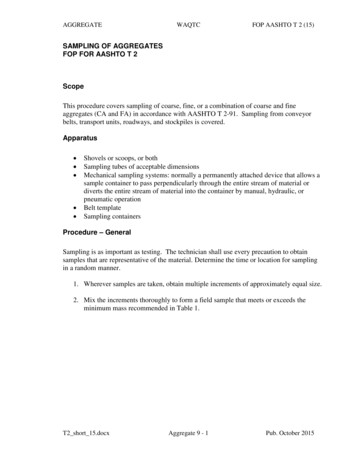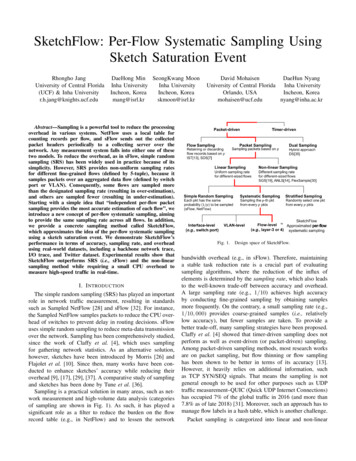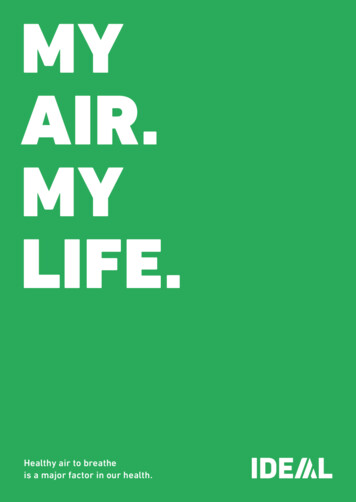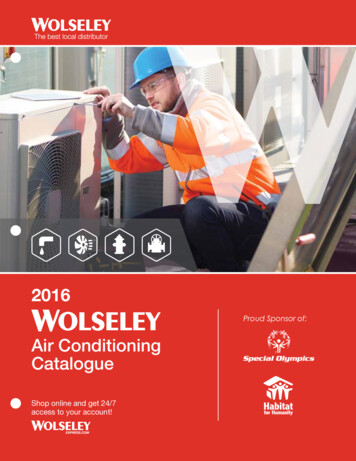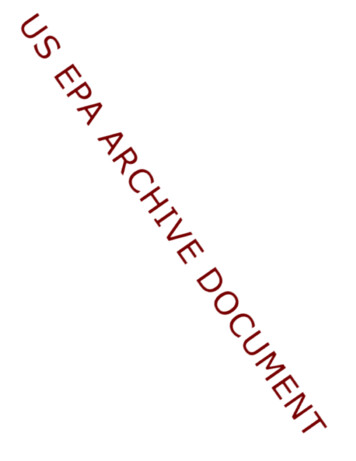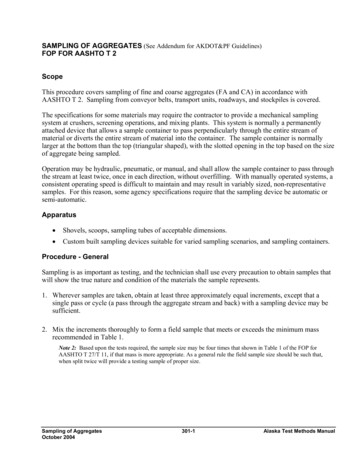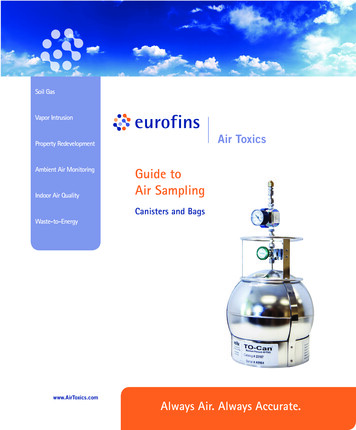
Transcription
Soil GasVapor IntrusionProperty RedevelopmentAmbient Air MonitoringIndoor Air QualityGuide toAir SamplingCanisters and BagsWaste-to-Energywww.AirToxics.comAlways Air. Always Accurate.
Eurofins Air Toxics, Inc.Guide to Whole Air Sampling – Canisters and BagsRevision 6/27/14ContentsSection 1.0 Introduction . 11.1Whole Air Sampling of VOCs . 11.2Choosing Between Canisters and Bags . 1Section 2.0 Canisters and Associated Media . 22.1Introduction to Canisters . 22.2Associated Canister Hardware . 3Section 3.0 Sampling with Canisters. 53.1Grab Sampling Using Canisters . 53.2Integrated Sampling with Canisters and Flow Controllers . 63.3Soil Gas Sample Collection. 9Section 4.0 Sampling with Bags . 144.1Introduction to Bags. 144.2Air Bag Sampling. 15Section 5.0 Special Sampling Considerations . 175.1Special Sampling Configurations. 175.2Considerations for Sampling at Altitude . 185.3Considerations for Soil/Landfill Gas Sampling . 185.4Considerations for Sample Cylinder Sampling . 19
Section 1.0 IntroductionEurofins Air Toxics Inc. presents this guide as a resource for individuals engaged in airsampling. Air sampling can be more involved than water or soil sampling due to thereactivity of chemical compounds in the gas matrix and sample interaction with theequipment and media used. Ensuring that air samples are collected properly is an importantstep in acquiring meaningful analytical results. This guide is not a substitute for experienceand cannot sufficiently address the multitude of field conditions. Note that this guide isintended for projects involving whole air sampling of volatile organic compounds (VOCs) incanisters and Tedlar bags. Eurofins Air Toxics provides the “Guide to Sorbent-BasedSampling - Volatiles and Semi-Volatiles” for other types of sampling.1.1Whole Air Sampling of VOCsThere are three general ways to collect compounds in a gas phase sample. A sampler maycollect the gas sample in a container, actively pump the vapor through a sorbent tube,solution or filter, or rely on passive sample collection onto a sorbent bed. This guidefocuses on collecting a sample in the most common air sampling containers, Summacanisters and bags. The sample may be collected in the container either passively, relying onan evacuated canister to drive the sample collection, or actively using a pump to fill thecontainer. The container is subsequently sealed and transported to the laboratory foranalysis. The sample is referred to as a “whole air sample” and the compounds remain inthe gas matrix inside the container.As a general rule, whole air sampling is appropriate when target compounds are chemicallystable and have vapor pressures greater than 0.1 torr at 25 C and 760mm Hg (EPA standardambient conditions). Performance of a given compound in a whole air sample is dependentupon its chemical properties, the matrix of the sample, and the degree of inertness of thesample container. 2014 Eurofins Air Toxics, Inc. All Rights Reserved1.2Choosing Between Canisters and BagsTable 1.2 compares the features and performance of Summa canisters and bags. Summacanisters or similarly treated canisters are rugged containers designed to provide superiorinertness and extended sample storage times. Evacuated canisters also do not require asampling pump for sample collection. By contrast, bags require a sample pump, but can bepurchased inexpensively in bulk, require little preparation or cleaning, and take up littlespace prior to use. Unlike canisters, bags are typically not appropriate for ppbv-level VOCmeasurements due to their background artifacts and short hold-times. Over time, lowmolecular weight gases can diffuse through the bag material while chemicals with lowervapor pressures can condense on the bag surface thereby compromising analyte recoveries.Call your Project Manager at 800-985-5955 if you have questions regarding the appropriatesampling media.Table 1.2Comparison of Canisters to BagsCanistersBagsType of SamplingPassive (vacuum)Active (pump required)Media Hold TimeUp to 30 days recommendedIndefiniteHold Time to AnalysisUp to 30 daysUp to 3 daysSurface InertnessExcellentFairCleanlinessBatch or 100% certified toppbv/pptv levelsSome VOCs present in theppbv rangeSampling ApplicationAmbient air, soil/landfill gasSoil/landfill gas, stationarysources, SVE systemsRule of Thumb“ppbv device”“ppmv device”AdvantagesInertness, hold time,ruggedness, no pumpPurchase/shipping cost,availability, conveniencePage 1
Section 2.0 Canisters and Associated MediaThis section provides a description of air sampling canisters, practical considerations forsampling, and step-by-step instructions for collecting grab and integrated samples.Photographs illustrate the correct way to assemble the various sampling components.Tables provide detailed information on many operational factors that ultimately influencethe quality of the data obtained from a canister sample.2.1Introduction to CanistersAn air sampling canister is a container for collecting a whole airsample. A canister may be spherical or cylindrical and isconstructed of specially treated stainless steel. The canister isprepared for sampling by evacuating the contents to a vacuumof approximately 29.9 inches of Mercury (in Hg). Opening thestainless steel bellows valve allows the air sample to enter thecanister. Flow controllers can be utilized to restrict the flowand allow for collection at a desired flow rate or over a desiredrange. When the sample has been collected, the valve is closed and the canister is returnedto the laboratory. Canisters range in volume from less than 1 liter (L) to 6 L. In general, 6 Lcanisters are used to collect ambient air samples and samples requiring time integrationgreater than 2 hours. One liter canisters are typically used for taking high concentration(i.e., greater than 5 ppbv) samples not requiring time integration such as soil vapor.2.1.1 Summa CanisterA Summa canister is a stainless steel container that has had the internal surfaces speciallypassivated using a “Summa” process. This process combines an electropolishing step with achemical deactivation step to produce a surface that is nearly chemically inert. A Summasurface has the appearance of a mirror: bright, shiny and smooth. The degree of chemicalinertness of a whole air sample container is crucial to minimizing reactions with the sample 2014 Eurofins Air Toxics, Inc. All Rights Reservedand maximizing recovery of target compounds from the container. Eurofins Air Toxicsmaintains a large inventory of Summa canisters in 1 and 6 L volumes.2.1.2 Canister CertificationEurofins Air Toxics provides two types of canister cleaning certification, batch and 100%,depending upon the requirements of the project. The batch certification process is mostappropriate for routine ambient air applications and high concentration applications such assoil vapor and landfill gas monitoring. The batch certification process begins by cleaning aset of canisters using a combination of dilution, heat and high vacuum. The cleaning batch iscertified by analyzing a percentage of canisters for approximately 60 VOCs using GC/MS.The batch meets cleaning requirements if the target compound concentrations are below0.2 ppbv. Alternatively, the 100% certification (i.e., individual certification) process istypically required for ambient and indoor air applications driven by risk assessment orlitigation requiring pptv (parts per trillion by volume) sensitivity. If 100% certification isrequired, canisters are individually certified for a client-specific list of target compoundsusing GC/MS. When the 100% certified canisters are shipped, the analytical documentationdemonstrating that they are free of the target compounds down to the project reportinglimits is emailed to the client. When sampling with certified media, it is important to notethat all media is certified as a train and must be sampled as such (i.e., a particular flowcontroller goes with a particular canister and is labeled as such).Specify whether your project requires batch or 100% canister certification.2.1.3 Canister Hold TimeMedia Hold Time: Unlike water and soil environmental samples, which are collected insingle-use, disposable vials and jars, air samples are collected in reusable summa canisters.Eurofins Air Toxics requires that canisters be returned within 15 days of receipt toeffectively manage our inventory and to insure canisters meet performance requirements inthe field. Evacuated canisters have a finite timeframe before the canisters naturally losePage 2
vacuum during storage. Using canisters beyond 15 days increases the risk of havingunacceptable initial vacuum at the start of sampling.Sample Hold Time: EPA Method TO-15 cites a sample hold time of up to 30 days for mostVOCs. Several non-routine compounds, such as bis(chloromethyl)ether, degrade quicklyand demonstrate low recovery even after 7 days. Reactive sulfur compounds such ashydrogen disulfide and methyl, ethyl, and butyl mercaptan are not amenable to storage instainless steel summa canister, and either fused silica lined (FSL) canisters or Tedlar bags arerequired for sample collection.2.22.2.2 Brass CapEach canister comes with a brass cap (i.e., Swagelok 1/4” plug) secured to the inlet of thevalve assembly. The cap serves two purposes. First, it ensures that there is no loss ofvacuum due to a leaky valve or a valve that is accidentally opened during handling. Second,it prevents dust and other particulate matter from damaging the valve. The cap is removedprior to sampling and replaced following sample collection.Always replace the brass cap following canister sampling.Associated Canister HardwareAssociated hardware used with the canister includes the valve, brass cap, particulate filterand vacuum gauge. (Flow controllers are covered in detail in section 3.2.)2.2.1 ValveAn industry standard 1/4” stainless steel bellows valve is mounted at the top of the canister.The valve maintains the vacuum in the canister prior to sampling and seals the canister oncethe sample has been collected. No more than a half turn by hand is required to open thevalve. Do not over-tighten the valve after sampling or it may become damaged. A damagedvalve can leak, possibly compromising the sample. Some canisters have a metal cage nearthe top to protect the valve.To protect the valve and provide secure connections in the field, a replaceable fitting isattached to all canisters. As threads wear and require replacement, new fittings can beinstalled at the laboratory prior to shipping to the field. You will need a 1/2” wrench tosecure the fitting while connecting or removing the required equipment to the canister. 2014 Eurofins Air Toxics, Inc. All Rights Reserved2.2.3 Particulate FilterParticulate filters should always be used when sampling with a canister. Separate filters areprovided to clients taking a grab sample, and filters are built into the flow controllers forclients taking integrated samples. The 2 micron filter is a frittedstainless steel disk that has been pressed into a conventional Swagelokadapter. This device has a relatively high pressure drop across thefritted disk and restricts the flow into the canister even when samplingwithout a flow controller. Table 2.2.3 lists the typical fill time for a grabsample using a 2 micron particulate filter.Table 2.2.3 Grab Sample Fill Times for CanistersCANISTER VOLUME2 micron filter6L 5 minutes1L 1 minutePage 3
2.2.4 FittingsAll fittings on the sampling hardware are 1/4” Swagelok, and a 9/16” wrench is used toassemble the hardware. A 1/2” wrench is also required to tighten fittings onto a unionconnector. Compression fittings should be used for all connections. Never use tube-in-tubeconnections. It is critical to avoid leaks in the sampling train. Leaks of ambient air throughfittings between pieces of the sampling train will dilute the sample and cause the canister tofill at a faster rate than desired. Eurofins Air Toxics can provide the necessary fittings andferrules if requested.2.2.5 Vacuum GaugeA vacuum gauge is used to measure the initial vacuum of the canister before sampling, andthe final vacuum upon completion. A gauge can also be used to monitor the fill rate of thecanister when collecting an integrated sample. Eurofins Air Toxics provides 2 types ofgauges. For grab sampling, a test gauge checks initial and final vacuums only and is not to besampled through. For integrated sampling a gauge is built into the flow controller and maybe used for monitoring initial and final vacuums, as well as monitoring t
Eurofins Air Toxics Inc. presents this guide as a resource for individuals engaged in air sampling. Air sampling can be more involved than water or soil sampling due to the reactivity of chemical compounds in the gas matrix and sample interaction with the equipment and media used. Ensuring that air samples are collected properly is an important step in acquiring meaningful analytical results .
